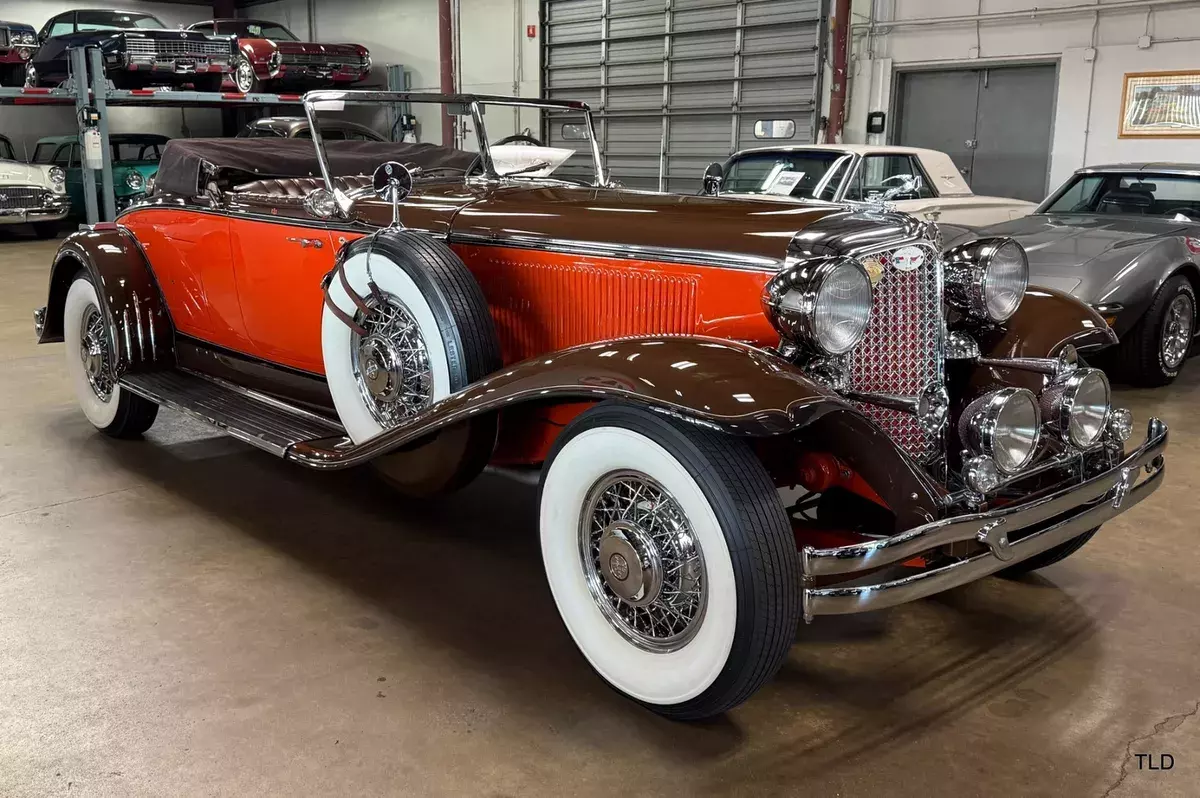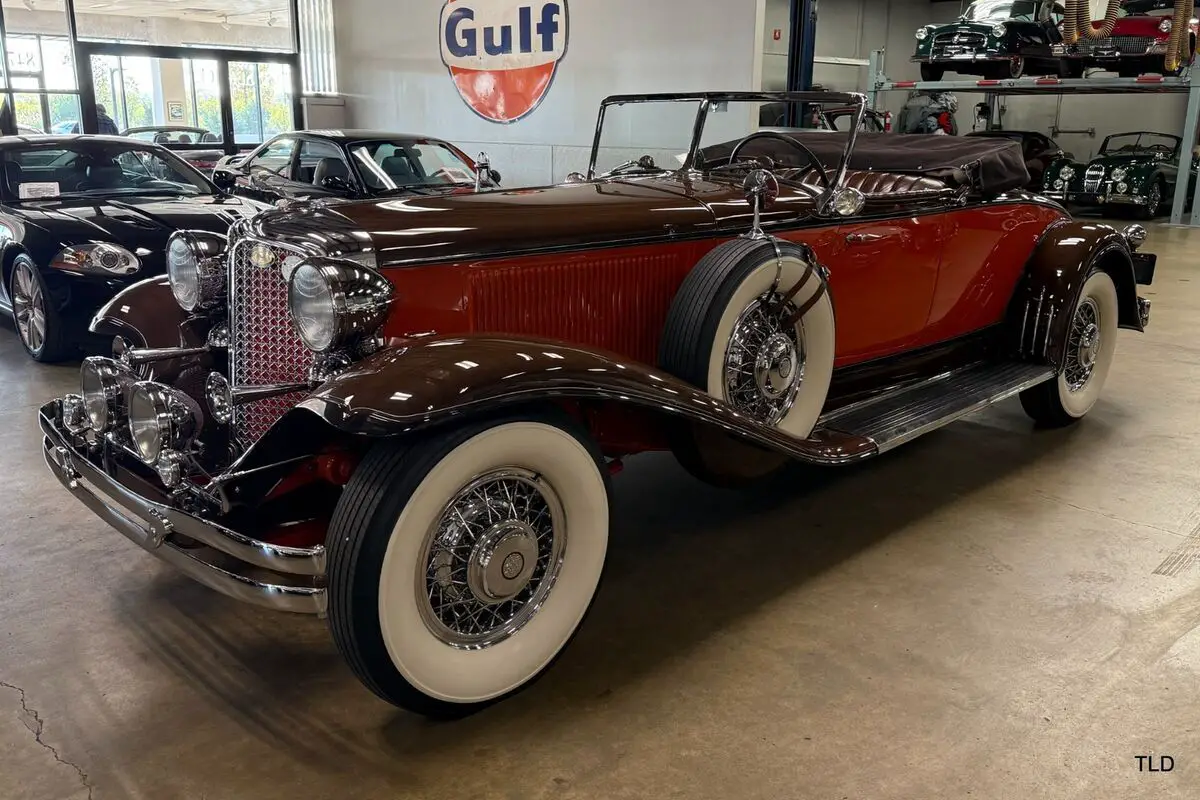1931 Chrysler CG Imperial Roadster, Orange & Brown with 100 Miles available now!
| Make: | Chrysler |
| Model: | CG Imperial Roadster |
| Type: | 2 Door |
| Year: | 1931 |
| Mileage: | 100 |
| VIN: | 7802053 |
| Color: | Brown |
| Engine: | 125HP 384CI Inline 8-Cylinder |
| Fuel: | Gasoline |
| Transmission: | Manual |
| Drive type: | -- |
| Interior color: | Brown |
| Vehicle Title: | -- |
1931 Chrysler CG Imperial Roadster Additional Info:
EPITOME OF CHRYSLER'S EARLYPROWESSRARE TOP-LINE CHASSIS BUILT FOR 1931 ONLYCCCA FULL CLASSIC RECOGNITION & ELIGIBILITYMULTIPLE AACA & CCCA AWARD-WINNING RESTORATIONPREVIOUSLY OWNED BY THOMAS F. DERRO2005 & 2010 BODY-OFF-FRAME RESTORATIONS384 CI INLINE 8-CYLINDER ENGINE3-SPEED MANUAL TRANSMISSION W/ FREEWHEELINGADVANCED ENGINEERING & RENOWNED DRIVING EXPERIENCEACCOMPANIED BY LIST OF AWARDS 2008-11READY TO TOUR, SHOW AND ENJOY! Rightly considered an icon of American industry, Walter P. Chrysler formed his self-named automotive marque from the ashes of the Maxwell-Chalmers merger in 1923. Beginning with a 70-horsepower Six built at the former Chalmers plant in Detroit, the new Chrysler debuted at New York's Commodore Hotel in January 1924. Featuring hydraulic brakes, a tubular front axle, aluminum pistons, and full-pressure lubrication, the new Chrysler represented the best and latest thinking in automobile design at introduction a tradition that would continue throughout company history. Delivering strong performance at a medium price point, Chrysler enjoyed immediate success with 32,000 produced by the end of 1924. In addition to their remarkable performance and durability, further attention was generated by new hill climb and speed records set by Indy legend Ralph De Palma with the new Chrysler in 1924 and 1925, establishing a stellar motorsports record that continues today. International acclaim came in 1925 when famed British record-setter Sir Malcolm Campbell hit 100 mph at Brooklands with a streamlined Chrysler. The company's first 24 Hours of Le Mans entries came in 1928, the year Chrysler acquired Dodge Brothers, with Chryslers finishing a credible 3rd and 4th in class, followed by 2nd, 3rd, and 4th at the Belgian 24-hour Grand Prix fabulous results for such a young company on its maiden outings. That enviable competition record continued in earnest with a succession of events through the early 1930s, including the debut of a Chrysler-powered entry at the 1930 Indianapolis 500. In 1931, Billy Arnold, the 1930 Indy 500 champion, set several stock-car racing records at Daytona behind the wheel of a Chrysler.At the turn of the 1930s, Chrysler introduced the mighty Imperial Eight and continued to update and reorganize its core six-cylinder offerings. At the top end of Chrysler's model range was the 8-cylinder CG Imperial, a premium model featuring a 145-inch wheelbase chassis, ideal for a wide array of factory-built Standard Line and coach built Custom Line bodies by LeBaron. Considered one of the best-proportioned and attractive automobiles of its era, the CG Imperial's basic styling was penned by Al Leamy, the self-taught design genius responsible for Cord's L-29. As with the L-29, the CG Imperial was low and long, featuring gracefully swept fenders and a striking vee-shaped chrome radiator shell. All Chryslers had a well-deserved reputation for performance, and the CG Imperial's 385 cubic-inch "straight eight" delivered, with its robust 125 horsepower rating. Their smooth four-speed synchromesh transmission, four-point engine mounts, hydraulic brakes, well-tuned suspension, and advanced steering geometry ensured that they were refined, with a surprisingly easy and comfortable experience. Introduced in July 1931, the CG Imperial was only produced through that December, with a few completed as 1932 models. According to marque experts, 3,228 CG Imperials were produced in all. This dashing 1931 Chrysler CG Imperial benefits handsomely from a body-off-frame restoration that was completed in 2010 and remarkably well-maintained ever since then. It is believed that this CG Imperial was originally fitted with closed coachwork and then accurately and carefully converted to its present Roadster body some 70 years ago. In the 1980s, it joined the collection of the late Thomas F. Derro, once regarded among the greatest classic auto collections in the Northeastern United States. Subsequently, it joined another esteemed prewar automobile collection and received its first body-off-frame restoration in 2005. The next owner acquired this CG Imperial, which already had a CCCA National First Prize Award to its credit, in 2007. Another restoration was commissioned in 2010, which included a paint refinish and the addition of a new convertible top, matching boot cover, and new side curtains, plus careful attention to fine details. Following this restoration, the CG Imperial earned a succession of honors, including the AACA Grand national First Prize, AACA Diamond Jubilee Award, and AACA Walter P. Chrysler Award, plus multiple Best in Class awards and numerous other accolades. Additionally, this CG Imperial served as the November photo subject for the 2012 AACA national calendar. A study in pure "Jazz Age" glamour and grandeur, this 1931 Chrysler CG Imperial features handsome two-tone livery, complemented by the Autumn Leaf upholstery and Tan Haartz canvas folding top. A CCCA badge, numbered 0903, is affixed. Desirable and correct period accessories include dual side mounted spares with mirrors, twin Pilot Ray driving lights, a color-matched trunk rack to the rear, and a chrome stone guard to the radiator, which mounts AACA badges. Renowned since new for delivering an outstanding, user-friendly driving experience, the rare CG Imperial is an ideal CCCA Full Classic automobile, eligible for an exceptionally wide array of shows, events, and classic tours. Expertly restored and maintained, it is simply a wonderful example of what many collectors regard the pinnacle of Chrysler engineering and style during the 1925-48 Classic Era recognized by the CCCA. Be sure to see this rare and exceptionally handsome 1931 Chrysler CG Imperial Roadster for yourself by contacting us for viewing arrangements, full details, and prepare to make it yours today!
EPITOME OF CHRYSLER'S EARLYPROWESS
RARE TOP-LINE CHASSIS BUILT FOR 1931 ONLY
CCCA FULL CLASSIC RECOGNITION & ELIGIBILITY
MULTIPLE AACA & CCCA AWARD-WINNING RESTORATION
PREVIOUSLY OWNED BY THOMAS F. DERRO
2005 & 2010 BODY-OFF-FRAME RESTORATIONS
384 CI INLINE 8-CYLINDER ENGINE
3-SPEED MANUAL TRANSMISSION W/ FREEWHEELING
ADVANCED ENGINEERING & RENOWNED DRIVING EXPERIENCE
ACCOMPANIED BY LIST OF AWARDS 2008-11
READY TO TOUR, SHOW AND ENJOY!
Rightly considered an icon of American industry, Walter P. Chrysler formed his self-named automotive marque from the ashes of the Maxwell-Chalmers merger in 1923. Beginning with a 70-horsepower Six built at the former Chalmers plant in Detroit, the new Chrysler debuted at New York's Commodore Hotel in January 1924. Featuring hydraulic brakes, a tubular front axle, aluminum pistons, and full-pressure lubrication, the new Chrysler represented the best and latest thinking in automobile design at introduction a tradition that would continue throughout company history. Delivering strong performance at a medium price point, Chrysler enjoyed immediate success with 32,000 produced by the end of 1924.
In addition to their remarkable performance and durability, further attention was generated by new hill climb and speed records set by Indy legend Ralph De Palma with the new Chrysler in 1924 and 1925, establishing a stellar motorsports record that continues today. International acclaim came in 1925 when famed British record-setter Sir Malcolm Campbell hit 100 mph at Brooklands with a streamlined Chrysler. The company's first 24 Hours of Le Mans entries came in 1928, the year Chrysler acquired Dodge Brothers, with Chryslers finishing a credible 3rd and 4th in class, followed by 2nd, 3rd, and 4th at the Belgian 24-hour Grand Prix fabulous results for such a young company on its maiden outings. That enviable competition record continued in earnest with a succession of events through the early 1930s, including the debut of a Chrysler-powered entry at the 1930 Indianapolis 500. In 1931, Billy Arnold, the 1930 Indy 500 champion, set several stock-car racing records at Daytona behind the wheel of a Chrysler.
At the turn of the 1930s, Chrysler introduced the mighty Imperial Eight and continued to update and reorganize its core six-cylinder offerings. At the top end of Chrysler's model range was the 8-cylinder CG Imperial, a premium model featuring a 145-inch wheelbase chassis, ideal for a wide array of factory-built Standard Line and coach built Custom Line bodies by LeBaron. Considered one of the best-proportioned and attractive automobiles of its era, the CG Imperial's basic styling was penned by Al Leamy, the self-taught design genius responsible for Cord's L-29. As with the L-29, the CG Imperial was low and long, featuring gracefully swept fenders and a striking vee-shaped chrome radiator shell. All Chryslers had a well-deserved reputation for performance, and the CG Imperial's 385 cubic-inch "straight eight" delivered, with its robust 125 horsepower rating. Their smooth four-speed synchromesh transmission, four-point engine mounts, hydraulic brakes, well-tuned suspension, and advanced steering geometry ensured that they were refined, with a surprisingly easy and comfortable experience. Introduced in July 1931, the CG Imperial was only produced through that December, with a few completed as 1932 models. According to marque experts, 3,228 CG Imperials were produced in all.
This dashing 1931 Chrysler CG Imperial benefits handsomely from a body-off-frame restoration that was completed in 2010 and remarkably well-maintained ever since then. It is believed that this CG Imperial was originally fitted with closed coachwork and then accurately and carefully converted to its present Roadster body some 70 years ago. In the 1980s, it joined the collection of the late Thomas F. Derro, once regarded among the greatest classic auto collections in the Northeastern United States. Subsequently, it joined another esteemed prewar automobile collection and received its first body-off-frame restoration in 2005. The next owner acquired this CG Imperial, which already had a CCCA National First Prize Award to its credit, in 2007. Another restoration was commissioned in 2010, which included a paint refinish and the addition of a new convertible top, matching boot cover, and new side curtains, plus careful attention to fine details. Following this restoration, the CG Imperial earned a succession of honors, including the AACA Grand national First Prize, AACA Diamond Jubilee Award, and AACA Walter P. Chrysler Award, plus multiple Best in Class awards and numerous other accolades. Additionally, this CG Imperial served as the November photo subject for the 2012 AACA national calendar.
A study in pure "Jazz Age" glamour and grandeur, this 1931 Chrysler CG Imperial features handsome two-tone livery, complemented by the Autumn Leaf upholstery and Tan Haartz canvas folding top. A CCCA badge, numbered 0903, is affixed. Desirable and correct period accessories include dual side mounted spares with mirrors, twin Pilot Ray driving lights, a color-matched trunk rack to the rear, and a chrome stone guard to the radiator, which mounts AACA badges. Renowned since new for delivering an outstanding, user-friendly driving experience, the rare CG Imperial is an ideal CCCA Full Classic automobile, eligible for an exceptionally wide array of shows, events, and classic tours. Expertly restored and maintained, it is simply a wonderful example of what many collectors regard the pinnacle of Chrysler engineering and style during the 1925-48 Classic Era recognized by the CCCA. Be sure to see this rare and exceptionally handsome 1931 Chrysler CG Imperial Roadster for yourself by contacting us for viewing arrangements, full details, and prepare to make it yours today!
























